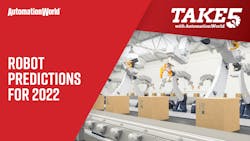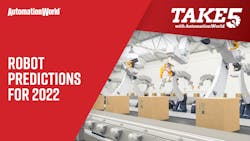
Quick hits:
- Electric vehicles require many components that internal combustion engine vehicles do not. As a result, new facilities will be built that are liable to employ autonomous mobile robots (AMRs) and other modular robotic technologies.
- In the e-commerce space, mass customization will drive the proliferation of flexible conveyance and robotics products.
- Increasing intelligence and adaptability may lead robots to penetrate new sectors, requiring worker retraining.
Hello and Welcome to another episode of Take Five with Automation World. I’m David Miller, Senior Technical Writer for Automation World. Today I’d like to go over some predictions that were made by ABB’s Robotics Division President Mark Segura about what kind of developments onlookers can expect to see for industrial robotics in the next year or so.
Now, again, the bulk of these predictions come from ABB’s Mark Segura, but they do mirror much of what we ourselves have uncovered and written about at Automation World in recent years. So, I’ll be sharing Mark’s predictions, but I’ll also be adding a few additional insights.
So, there are three key trends Mark emphasizes. Number one is that the growing proliferation of electric vehicles will bring changes to automotive manufacturing, which will be felt in increased demand for certain types of robots. To give some more perspective on this, Bloomberg estimates that worldwide EV sales will increase from 1.1 million in 2017 to 11 million by 2025. And that’s for a variety of reasons that we don’t really need to go into here. What’s more important from out standpoint is that it requires new manufacturing facilities and procedures because the manufacturing process for EVs is different than for internal combustion engine vehicles, and requires different components, the most prominent of which is of course the EV’s battery.
Now, automotive manufacturers will want to bring the production of batteries as close as possible to vehicle assembly for a multitude of reasons, and this means new facilities will need to be built. When you build new facilities rather than upgrading old facilities, you are more likely to buy the latest and greatest tech on the market, simply because you can. You can start from scratch, so why not build the best facility possible? The result is going to be that these new facilities are built to be responsive to an environment in which demand is more unpredictable, meaning that they will most likely adopt modular and flexible as opposed to fixed production models. That means mobile robotics and other flexible technologies. So, this is somewhere where we could see AMRs, for instance, really blow up.
Trend two. E-Commerce will create more demand for flexible robotic technologies. Now, this is something we’ve talked about a great deal before. When it comes to e-commerce what we’re looking at is many different goods – increasingly being customized down to single units -- being ordered in many different combinations to customers in many different locations. So in order to produce, pack out, and ship these goods efficiently, tremendous flexibility is needed on the part of machinery. Because there’s no way that you can do 20 different changeovers on a single line for 20 different customized products and remain efficient – so the line needs to be able to run multiple products without changeover, or changeover needs to be incredibly rapid and software driven. We’ve covered this in some detail particularly in regard to flexible conveyance systems such as Beckhoff’s XTS and B&R Automation’s Acopostrak, which I’ve included some links to more material on below. But basically, this trend is expected to continue, and will effect the type of robots we see deployed moving forward.
Trend three – Final trend for this video. Robot use will expand into new sectors of the economy, and it will require mass retraining of workers even in non-industrial professions. Now the interesting thing about this is that even though it’s a trend that will eventually see robots penetrate healthcare, retail, and food it still begins with industry. What’s happening is that the need among smaller, less experienced industrial companies for robots is leading to an uptick in very adaptable, intuitive, collaborative robots, which can be programmed incredibly simply and can work directly alongside humans. So, we see this as small machine shops and businesses like that. But once that technology is developed, the prices come down, and it becomes easier for other sectors to begin integrating these very safe, adaptable, and intuitive robots.
And if that were to occur, it would actually be a huge cultural shift, because it would involve large portions of society working with robots. In this scenario, you would really want familiarity with robots nurtured not just at the college, but also the primary and secondary levels. So that’s significant.
In any case, that’s all I have for you today. Thanks for watching.
